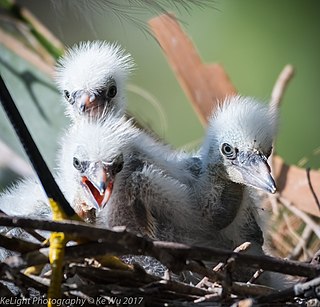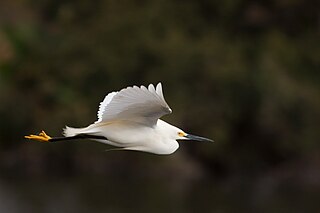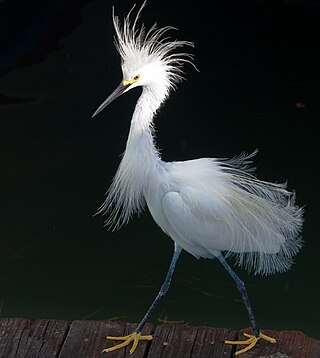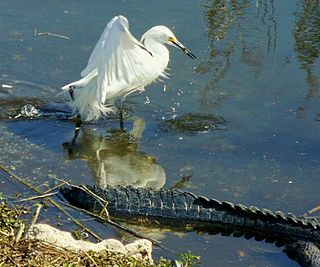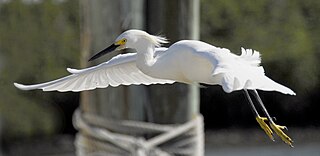Snowy Egret
Appearance
Snowy Egret (Egretta thula) is a medium-sized heron with a delicate build. Adult egrets generally measure between 22" to 26" (56 to 66 cm) and have a wingspan of approximately 39" (100 cm). Egrets average 13oz (370 g) in weight with the males tending to be slightly larger than the females.[1]
Snowy Egrets have entirely white plumage, a long, slender black bill, bright yellow lores (marks around the eyes), and long, slender black legs with bright yellow feet. Their eyes are yellow. Breeding adults develop long, delicate plumes off their breast and are also characterized by their change in foot color, from yellow to orange.[2][3] [4]
Range
Snowy Egret (Egretta thula) is found throughout North, Central, and South America as well as the Caribbean. It breeds in coastal and inland wetlands, but its range limits have changed over time due to the effects of hunting and habitat loss. Small breeding populations are located in Nova Scotia, Canada, and more heavily populated locations are found across the United States.
Snowy Egrets are common among northern Nevada, Utah, and southeastern states, especially Florida and states bordering the Gulf of Mexico. This egret is most prevalent throughout Mexico, Central America, and South America.
Egretta thula is a partially migratory species, as it relocates from its northern habitats of the United States and Canada to its winter ranges located in Mexico, Central America, South America, the West Indies, and Bermuda. Snowy Egrets begin their northward migration in early March and depart in September to migrate to their wintering areas. [4]
Habitat
Snowy Egrets generally prefer an environment of shallow water inlets for feeding purposes. Salt-marsh pools, tidal channels, shallow bays, and mangroves are among the most preferred habitats in North America. Habitats are most common among coastal areas and islands due to the availability of stable and abundant food sources.
During the winter months, egrets migrate to the Caribbean to nest and roost in the mangroves. The Caribbean is home to other favorable egret habitats including salt-water lagoons, freshwater swamps, grassy ponds, beaches, shallow reef areas, flooded rice fields, and wet grassy meadows.
Throughout Central America, Snowy Egrets prefer mainly lowland areas near freshwater swamps, lakes, and large river mouths. South American species also prefer coastal mangroves, mudflats, and swamps rather than highland areas. [3][4]
Life History
Breeding begins in late March or early April when the male egrets perform flight displays and sound vocalizations to attract female mates. The most common courtship display is the "Stretch" display, in which the male pumps his body up and down with his bill pointed towards the sky. The male then produces a call to attract females. The changing foot color from yellow to reddish-orange indicates the beginning of breeding behaviors. Breeding adults are also characterized by the distinctive display of long, delicate plumes off their breasts. Once a male finds a mate, the pair performs sexual displays and eventually builds a nest for their offspring. [4][5]
The male and female pair-bond is maintained through a series of sexual displays. Breeding begins in March or early April. Female egrets usually build nests in the territories defended by the males. Nests are often built-in isolated, estuarine habitats and can be located either on the ground or as high as 30 feet in the trees. The nests are composed of woven twigs and small sticks that female egrets collect from the ground or steal from other nests. Egretta thula may also reuse old nests. These egrets are highly social nesters and build nests close to other egrets or herons. No preliminary rituals are performed prior to copulation, which takes place in the nest. Males stand on the backs of females and cloacal cavities come into contact during copulation to fertilize the eggs. The average duration of the contact is 10 seconds. Females lay 3-6 eggs at a time (on average); eggs have a pale, greenish-blue color. Incubation lasts 24 days on average and the chicks usually fledge 14 days after hatching. Young reach reproductive maturity after 1 to 2 years.[6][4]
Both parents incubate the eggs and feed the nestlings by dropping food into the nest. Once the eggs hatch, parents remove the eggshells from the nest. Both parents brood their altricial young continuously until the hatchlings are 10 days old. From 10 to 14 days, only one parent is present in the nest to brood the young. After 10 days, parents are only in the nest 50% of the time. However, when storms occur, the young are brooded continuously. During the first five days after hatching, parents feed their young by regurgitating food onto the nest floor for the hatchlings to eat. Sometimes the parents' bill is placed directly into the hatchlings' mouth and food is regurgitated. (Parsons and Master, 2000) The younger nestlings are fed before the older hatchlings. The nestlings leave the nest after two weeks, but some may leave the nest as early as 10 days. [3][4]
The hatchling is a grayish color with a dark blue area around the eyes and a pale, pinkish-gray bill. Nestlings are covered in white down except for their wings. Pinfeathers appear by the first week. Juvenile feathers emerge on the body and wings by 2 to 3 weeks of age. Leg color varies from yellow to black. The hatchlings have a yellow-colored bill tipped with black until five weeks of age, when the entire bill changes to black.
The Snowy Egret has a 71.6% mortality rate during its first year and a 31.4% mortality rate during years 2 to 17. Snowy egrets generally live between 2 and 17 years, the oldest was recorded in Utah and lived 22 years, 10 months. [2]
Behavior
The Snowy Egret walks upright with its wings held close to its body. This upright posture is ideal for foraging because it allows the egret to make quick directional changes to catch its prey.
Snowy egrets are most active when foraging at dawn and dusk. They spend most of the day resting and engaged in self-maintenance behaviors that include grooming their wings, head-scratching to remove insects on their body, and bathing. Males keep busy protecting their nesting territory.
The Snowy Egret is a highly social bird that engages in group foraging with other aquatic bird species. Group interaction with other bird species is also common in nesting territories.
Snowy egrets avoid predators such as owls, hawks, poisonous snakes, and raccoons. [4][5]
Communication and Perception
Snowy Egrets communicate through sound vocalizations and posture. Young birds produce soft, buzzing calls and mature birds produce high and low-pitched calls. High-pitched calls signify plentiful foraging sites and low-pitched calls signify aggressive situations.
Greeting calls are common among egrets. Only males tend to use high sound vocalizations, especially to attract a female mate. Communication sounds are also used to defend the territory surrounding the nest. An egret's upright posture with fully erect feathers marks the onset of an attack on another bird. [3][4]
Food Habits
Snowy Egrets prefer foraging habitats near bodies of shallow water, which are ideal for food sources. Its broad diet consists of earthworms, annelid worms, aquatic and terrestrial insects, crabs, shrimp, crayfish, snails, freshwater and marine fish, frogs, toads, lizards, and snakes. The egret's diet is generally composed of 75% fish and 25% crustaceans.
The Snowy Egret has the widest range of foraging behaviors when compared to other herons. Food capturing is performed by pecking, walking slowly or quickly, running, hopping, hovering, and "disturb and chase" behaviors.
Snowy egrets primarily feed during the early morning and evening hours. Egrets occasionally engage in group flights to fly to far-away foraging environments. Otherwise, egrets independently fly approximately 3 km from their colonies to foraging sites. However, foraging in larger groups allows for greater success in finding substantial food sources and helps provide protection from predators.[3][4]
Predation
Snowy Egrets have shown an increased preference for island nest sites in urbanized, coastal estuaries. Egrets choose urbanized locations over isolated locations because isolated locations have more predators. Egrets use flight to escape predation from terrestrial animals and they are known to have innate recognition and avoidance of poisonous snakes.[4]
Known Predators
- raccoons (Procyon lotor)
- great horned owls (Bubo virginianus)
- barred owls (Strix varia)
- American crows (Corvus brachyrhynchos)
- fish crows (Corvus ossifragus)
- American alligators (Alligator mississipiensis)
- gray rat snakes (Elaphe obsoleta spiloides)
- common black-hawks (Buteogallus anthracinus)
Threats
In the United States from 1880 to 1910, adult egrets were shot by plume hunters. Egretta thula was hunted for its delicate back plumes that were used to decorate women's hats and clothing. In 1886, plumes were valued at $32 per ounce, which was twice the price of gold at the time. In 1910, most hunting ceased due to citizens' requests to stop the slaughter of egrets. However, hunting still continued in Central and South America due to the European demand for plumes.[4]
Snowy Egrets have been protected in North America since 1916 under the Migratory Bird Treaty Act. The Migratory Bird Treaty Act prohibited the hunting of egrets for their plumes, thus allowing them to return to their previous levels of abundance.[4]
Snowy Egrets are at risk of chemical contamination and the decline of wetland environments they depend on for food. Eggs in agricultural areas are contaminated by pesticides, which cause death.[7]
Snowy Egrets are subject to nematode parasitism, which causes death. Starvation and inclement weather are likely causes of death for young nestlings.[4]
Snowy Egrets have died from the consumption of styrofoam, plastics, and lead found in the environment.
Snowy Egrets are often lost due to entanglement in fishing line and nets.
Conservation Status
Since the 1950s, numbers in Florida have been declining, possibly faster than declines of other herons and egrets. In 1989, this species was found in only 22 percent of the colonies where it formerly occurred. Persistent patterns of wetland destruction and alteration are probably eliminating large areas of essential habitat. Most impacts appear to affect the quality of foraging habitat rather than areas immediately surrounding nesting colonies.
Protection and Management
Prevent rapid changes in water depth in managed wetlands that will likely adversely affect the quality of foraging. Restore and maintain natural hydroperiods in degraded wetland areas.
Protect breeding and foraging habitats through the establishment of preserves and regulation of wetlands. The Florida Fish and Wildlife Conservation Commission and the Department of Environmental Protection have developed setback distances around wading bird colonies of 330 ft. (100m) to prevent human disturbance.
Ecosystem Indicator Roles
The Snowy Egret serves as a biological indicator of ecosystem health and habitat quality. In marshes, bays, and swamp habitats, the absence of egrets may reflect disturbances in the ecosystem, such as pollution, contamination of water, habitat loss, or human disturbance.
In some habitats, researchers have sampled eggs and feathers to test levels of environmental contamination. Egrets are positioned at the top of the food chain, thus their decline may also infer a decline of other species, such as fish or insects. Egretta thula is a highly social bird and will not attack humans or disturb other bird species in its habitat.[5]
Video
Snowy Egrets at Merritt Island National Wildlife Refuge
See Also
Weblinks
- Animal Diversity - Snowy Egret (Egretta thula)
- Encyclopedia of Life - Snowy Egret
- Cornell Lab - Snowy Egret
- All About Birds - Snowy Egret
- Audubon - Snowy Egret
Documents
- Florida Natural Areas Inventory 2001 - Snowy Egret Profile (PDF, 2pp, 40KB)
- South Florida Wading Bird Report (PDF 55pp 8.5MB
References
- ↑ Weslosky, A. 2002. "Egretta thula" (On-line), Animal Diversity Web. Accessed September 24, 2020 at https://animaldiversity.org/accounts/Egretta_thula/
- ↑ 2.0 2.1 Chandler, R. 1997. Snowy Egret. Journal of Field Ornithology, 68: 287-295.
- ↑ 3.0 3.1 3.2 3.3 3.4 Howell, S., S. Webb. 1995. A Guide to the Birds of Mexico and Northern Central America. Oxford: Oxford University Press.
- ↑ 4.00 4.01 4.02 4.03 4.04 4.05 4.06 4.07 4.08 4.09 4.10 4.11 4.12 Parsons, K., T. Master. 2000. Snowy Egret. The Birds of North America, 489: 1-23.
- ↑ 5.0 5.1 5.2 Robbins, C. 1966. A Guide to Field Identification Birds of North America. New York: Western Publishing Company.
- ↑ Bowles, M. 1991. "Snowy Egret" (On-line). Accessed 12/09/03 at http://www.inhs.uiuc.edu/chf/pub/ifwis/birds/snowy-egret.html.
- ↑ (https://www.pwrc.usgs.gov/bioeco/snowy.htm USGS - BIOLOGICAL AND ECOTOXICOLOGICAL CHARACTERISTICS OF TERRESTRIAL VERTEBRATE SPECIES RESIDING IN ESTUARIES)



